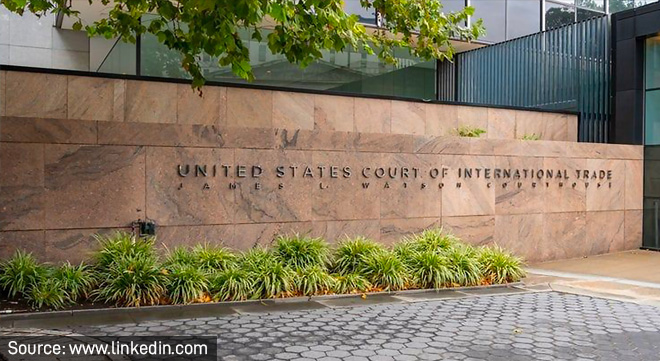The United States Court of International Trade yesterday declared that President Donald Trump’s use of emergency powers to impose tariffs on imported goods exceeded his constitutional authority.
The decision, which blocks most of the tariffs introduced under the International Emergency Economic Powers Act (IEEPA), marks a legal setback for the Trump administration’s trade policy.
However, the ruling does not necessarily mean the end of Trump’s tariff agenda, because it leaves room for alternative legal pathways. And the administration has filed an appeal, setting the stage for a protracted legal battle that could reach the Supreme Court.
The tariffs were announced by Trump on 2 April as part of his broader strategy to reduce the US trade deficit, which stands at $1.2 trillion. The tariffs ranged from 10% to 54% or higher, with the steepest rates targeting countries such as China.
The administration justified the tariffs by invoking the IEEPA, which allows the president to regulate commerce during national emergencies. Trump declared the trade deficit a “national emergency”, arguing it threatened American jobs and weakened the country’s defence industrial base.
However, the tariffs faced immediate backlash from businesses and states. On 14 April, five small US businesses – VOS Selections, FishUSA, Genova Pipe, MicroKits LLC, and Terry Precision Cycling – filed a lawsuit, V.O.S. Selections, Inc. v. Trump, arguing the tariffs were unconstitutional and caused severe economic harm, including supply chain disruptions and cash flow issues.
Separately, 12 US states with Democratic governors, including California and Oregon, filed a lawsuit claiming the tariffs unlawfully increased the cost of imported goods used for public services.
The legal challenges centred on whether the president could use the IEEPA to impose tariffs, a power traditionally reserved for Congress under the US Constitution. Article I, Section 8 of the Constitution explicitly grants Congress the authority to “lay and collect taxes, duties, imposts, and excises” and to “regulate commerce with foreign nations”. The plaintiffs argued that Trump’s actions amounted to an unconstitutional overreach of executive power.
The Court of International Trade is a federal court in Manhattan that handles disputes over customs and international trade laws.
What the court ruled
The three-judge panel at the Court of International Trade – composed of judges appointed by presidents Ronald Reagan, Barack Obama, and Trump – ruled in favour of the plaintiffs.
The court held that although the IEEPA grants the president broad powers during national emergencies, it does not override Congress’s exclusive authority to regulate commerce.
The judges concluded that Trump’s tariffs were an impermissible use of emergency powers and issued a permanent injunction blocking all tariff orders rooted in the IEEPA since January 2025.
However, the ruling did not affect industry-specific tariffs on automobiles, steel, and aluminium, which were imposed under a different legal basis – section 232 of the Trade Expansion Act. These tariffs, which are tied to national security concerns, remain in place.
The court gave the executive branch up to 10 days to issue new orders reflecting the injunction, creating uncertainty in ongoing trade negotiations with the European Union, China, and other trading partners.
The decision is the first time a federal court has struck down a significant portion of Trump’s tariffs, following at least seven legal challenges. The ruling also comes amid a temporary reduction in tariffs between the US and China, agreed upon on 12 May, which saw both countries slash tariffs for at least 90 days.
Other avenues open to Trump
Despite the ruling, Trump has several alternative legal pathways to maintain his tariff agenda:
- Section 122 of the Trade Act of 1974, which allows temporary tariffs up to 15% for 150 days without investigation, requiring Congressional action afterwards.
- Section 301 of the Trade Act of 1930, which permits investigations into unfair trade practices, leading to tariffs, typically taking several weeks.
- Section 338 of the Trade Act of 1930, which enables up to 50% levies on imports from countries discriminating against US goods, although it has not been used before.
Goldman Sachs viewed the ruling as a “setback” but not a definitive end to Trump’s tariff plans. They described it as a temporary hurdle, expecting the administration to leverage other tools such as sections 122 and 301. Alec Phillips from Goldman Sachs told Bloomberg that “for now, we expect the Trump administration will find other ways to impose tariffs”.
Goldman also notes that the ruling does not block sector-specific levies, maintaining some tariff continuity. The ruling increases uncertainty but might not alter the final outcome for most major US trading partners.
White House files appeal
The Trump administration responded swiftly to the ruling, condemning the decision and defending the tariffs as essential to addressing the trade deficit.
A White House spokesperson stated, “US trade deficits constitute a national emergency that has decimated American communities, left our workers behind, and weakened our defence industrial base – facts that the court did not dispute.”
The administration also criticised the involvement of “unelected judges” in economic policy, suggesting that the ruling undermined necessary actions to protect American interests.
The ruling is likely just the beginning of a longer legal battle.
The White House has already filed an appeal to the US Court of Appeals for the Federal Circuit, questioning the Court of International Trade’s authority to rule on the matter. The case could take months to resolve.
If the Federal Circuit upholds the lower court’s decision, the administration may petition the Supreme Court to hear the case, given its implications for the balance of power between the executive and legislative branches.
Meanwhile, the injunction creates immediate challenges for the administration’s trade policy. With most IEEPA-based tariffs blocked, the US may need to renegotiate its approach to trade with key partners. The ruling also emboldens critics of the tariffs, including businesses and states that have argued for a more measured approach to addressing trade imbalances.
Financial markets reacted to the ruling, with the US dollar rallying and Wall Street futures rising in response to the reduced uncertainty surrounding tariffs. However, the long-term economic impact remains unclear as the legal process unfolds and the administration explores alternative strategies to achieve its trade goals.




